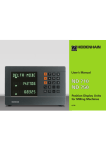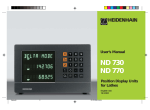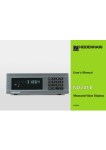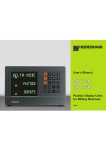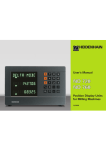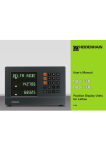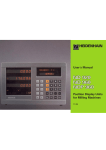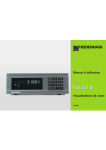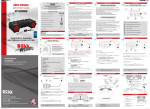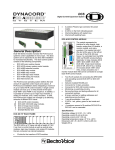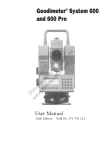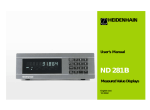Download 36712621 - heidenhain
Transcript
User’s Manual
ND 760 E
Position Display Units
for EDM
English (en)
1/ 2002
titel.pm6
2
07.02.2002, 08:30
ND 760 E Position Display Unit
(for 3 axes)
Status display:
SET = Datum setting
REF = Blinking:
Traverse the
reference points.
On continuously:
Reference points
have been traversed.
D=
SHIFT function
1 2
Datum 1 or 2
Inch = Display in inches
SCL = Scaling factor
->II<- = Touch-off / Centerline
HEIDENHAIN
Bateil1.pm6
2
21.01.2002, 09:39
• Select coordinate axis
• Select axis-specific operating
parameters
Trigger points 1 and 2 before reaching the erosion
depth
Keys
Keys
Trigger point with respect to MIN position
Add key for the erosion depth
Numerical input
TP3, TP4
Additional switching points, defined with
respect to the top of the workpiece = 0
Trigger point for start position (HOME)
• Select datum 1 or 2
• Page backward in the list of special functions
• Page backward in the parameter list
• Cancel entry
• Reset the operating mode
• Zero the selected axis (if activated with P80)
• Select parameter: CL plus two-digit number
• Select the special functions
- Probe for center line
- mm/inch switchover
- Parameter entry
• Page forward in the list of special functions
Bateil1.pm6
3
Trigger point for the erosion depth
Switchover from actual position display to MIN
position display
• Change algebraic sign
• Call the most recent dialog
• In the parameter list: change the parameters
SHIFT key
Use of double-function keys
• Confirm entry
• Page forward in the parameter list
21.01.2002, 09:39
3
4
Bateil1.pm6
4
21.01.2002, 09:39
Part I Operating Instructions
ND 760 E for three axes
Fundamentals
366 590-01
About this manual
This manual is divided into two parts:
Part I: Operating Instructions
Fundamentals of positioning
ND functions
6
Switch-on, Traversing the Reference Marks
12
Datum Setting
13
Working with a Scaling Factor
16
MIN Position Display in the EDM Axis
17
Programming the Trigger Points
18
Add Key
19
Description of Switching Output Functions
20
Error Messages
23
Part II
Installation and
Specifications
Page 25
and following
Part II: Installation and Specifications
Description of operating parameters
Switching inputs, switching outputs
Part I Operating Instructions
This Manual describes the ND 760 E position display
unit with the following software number or higher:
5
Bateil1.pm6
5
21.01.2002, 09:39
Fundamentals
Fundamentals
The ND 760 E position display unit was conceived for use on
electrical discharge machines (EDM).
The following functions support operation with EDMs:
7 switching outputs for the EDM axis
Display of the MIN position, the distance-to-go, and the
total depth in the EDM axis. Because of the quick up-anddown motion of the EDM axis, HEIDENHAIN
recommends displaying only the last minimum position
value.
Simple compensation of the erosion depth with the aid of an
add key.
Simple setup function for finding the center line between
two edges.
6
Bateil1.pm6
6
21.01.2002, 09:39
+Y
+Z
Graduation
Coordinate system
To describe the geometry of a workpiece, the Cartesian* coordinate
system is used. The Cartesian coordinate system consists of three
mutually perpendicular axes X, Y and Z. The point of intersection of these
axes is called the datum or origin of the coordinate system.
+X
–X
Datum or
origin
Fundamentals
You can skip this chapter if you are already familiar with
coordinate systems, incremental and absolute dimensions,
nominal positions, actual positions and distance-to-go.
Think of the axes as scales with divisions (usually in millimeters) which
allow us to fix points in space referenced to the datum.
To determine positions on a workpiece, the coordinate system is laid
onto the workpiece.
–Z
The machine axes are parallel to the axes of the coordinate system.
The Z axis is normally the tool axis.
–Y
Z
Y
X
*) Named in honor of the French mathematician and philosopher
René Descartes (1596 to 1650)
Bateil1.pm6
7
7
21.01.2002, 09:39
250
0
125
216,5
-250
-216,5
-125
The workpiece drawing is used as the basis for machining the workpiece.
To enable the dimensions in the drawing to be converted into traverse
distances of machine axes X, Y and Z, each drawing dimension requires
a datum or reference point on the workpiece (since a position can only be
defined in relationship to another position).
216,5
125
1225
The workpiece drawing always indicates one absolute datum (the datum
for absolute dimensions). However, it may contain additional relative
datums.
-125
-216,5
0
8
21.01.2002, 09:39
900
950
700
450
0
Absolute
datum
8
Bateil1.pm6
Relative
datums
-150
0
300±0,1
320
0
You can set up to 9 absolute datum points and store them in
nonvolatile memory.
-250
150
750
In the context of a numerical position display unit, datum setting means
bringing the workpiece and the tool into a defined position in relation to
each other and then setting the axis displays to the value which
corresponds to that position. This establishes a fixed relationship
between the actual positions of the axes and the displayed positions.
250
0
325
Fundamentals
Datum setting
Z
Each position on the workpiece is uniquely defined by its absolute
coordinates.
Example
Absolute coordinates of position 1 :
X = 10 mm
Y = 5 mm
Z = 0 mm
Y
If you are working according to a workpiece drawing with absolute
dimensions, you are moving the tool to the coordinates.
X
1
Fundamentals
Absolute workpiece positions
5
Relative workpiece positions
10
A position can also be defined relative to the previous nominal position.
The datum for the dimension is then located at the previous nominal
position. Such coordinates are termed incremental coordinates or chain
dimensions. Incremental coordinates are indicated by a preceding I.
Example
Relative coordinate of position 2 referenced to
position 1 :
IX = 10 mm
IY = 10 mm
If you are working according to a workpiece drawing with incremental
dimensions, you are moving the tool by the dimensions.
Z
Y
2
10
Sign for incremental dimensioning
A relative dimension has a positive sign when the axis is moved in the
positive direction, and a negative sign when it is moved in the negative
direction.
1
1
10
5
10
Bateil1.pm6
9
X
21.01.2002, 09:39
9
Fundamentals
Nominal position, actual position and distance-to-go
Z
The position to which the tool is to move is called the nominal position
moment is called the actual position ( I ).
The distance from the nominal position to the actual position is called the
S
I
( S ). The position at which the tool is actually located at any given
R
Y
distance-to-go ( R ).
X
Sign for distance-to-go
When you are using the distance-to-go display, the nominal position
becomes the relative datum (display value 0). The distance-to-go is
therefore negative when you move in the positive axis direction, and
positive when you move in the negative axis direction.
10
Bateil1.pm6
10
21.01.2002, 09:39
The position encoders on the machine convert the movements of the
machine axes into electrical signals. The ND display unit evaluates these
signals, determines the actual position of the machine axes, and displays
the position as a numerical value.
Z
Workpiece
Y
If the power is interrupted, the relationship between the machine axis
positions and the calculated actual positions is lost. The reference marks
on the position encoders and the REF reference mark evaluation feature
enable the ND to quickly re-establish this relationship again when the
power is restored.
X
Fundamentals
Position encoders
Position
encoder
Reference marks
The scales of the position encoders contain one or more reference
marks. When a reference mark is crossed over, a signal is generated
which identifies that position as a reference point (scale datum =
machine datum).
When these reference marks are crossed over, the ND's reference
mark evaluation feature (REF) restores the relationship between axis
slide positions and display values which you last defined by setting the
datum. If the linear encoders have distance-coded reference marks,
you need to move the machine axes a maximum of only 20 mm to do
this.
Scale in
linear encoder
Reference marks
Bateil1.pm6
11
21.01.2002, 09:39
Distance-coded
reference marks
11
Switch-on, Traversing the Reference Marks
Switch-on, Traversing the Reference Marks
0è1
Turn on power (switch located on rear panel). REF
in the status display starts blinking.
ENT...CL
ENT
Confirm reference traverse mode. REF indicator
stops blinking and stays on. Decimal points blink.
Cross over the reference marks in all axes (in any
sequence). Each axis display becomes active when
its reference mark is crossed over.
Crossing over the reference marks stores the most recently defined
assignment of display values to axis slide positions for datum points 1
and 2 in nonvolatile memory.
Note that if you choose not to traverse the reference marks (by clearing
the dialog ENT ... CL with the CL key), this relationship will be lost if the
power is interrupted or when the unit is switched off.
12
Bateil1.pm6
If you wish to use multipoint axis error compensation, you
must traverse the reference marks (see Multipoint axis error
compensation)!
12
21.01.2002, 09:39
If you want to save the datum points in nonvolatile
memory, you must first cross over the reference
marks.
To call a datum you have set, proceed as follows:
You have set two datum points in P70:
Select datum 1 or 2.
Only after crossing over the reference marks can you set new
datums or activate existing ones.
In P70, you can select:
Two datum points: The selected datum point
is displayed via 1 or 2
Nine datum points: The selected datum point
is displayed in the uppermost axis via d1 to d9.
You set a datum by first pressing the corresponding axis key
and then entering a numerical value. To transfer the new
datum, press the ENT key. The CL key can be used to clear
an incorrect entry.
Datum Setting
Datum Setting
You have set nine datum points in P70:
Press the datum key (d starts
blinking).
1
ENT
Enter a datum number (1 to 9).
13
Bateil1.pm6
13
21.01.2002, 09:39
Datum Setting
Probing workpiece edges to find a centerline datum
Z
The edges to be probed run parallel to the Y axis.
Follow the procedure below for all centerlines between two edges.
Select a datum number (see page 13).
Y
2
1
SPEC
FCT
X=0
Select the special functions.
PROBE MIDP.
ENT
X
Confirm the probe centerline
function. SET lights.
Select the X axis (if not already selected).
The >❘❘<- status symbol starts blinking.
1ST POS X (appears only briefly)
Touch the workpiece edge 1 with the tool.
14
Bateil1.pm6
14
M
21.01.2002, 09:39
X
Datum Setting
The first position value 1 is captured.
ENT
Retract the tool from the workpiece.
2ND POS X (appears only briefly)
Touch the workpiece edge 2 with the tool.
The second position value 2 is captured.
ENT
After the second position has been transferred, the center line
between the two edges is calculated and set as a datum. The current
position (2nd position probed) in relation to the center line is
displayed. Then the function is automatically terminated.
The function is always effective for the currently active axis (it is
possible to switch the axis before the 1st position has been
transferred).
SPEC
FCT
or
CL
Exit the probing functions.
15
Bateil1.pm6
15
21.01.2002, 09:39
Scaling factors enable you to increase or decrease the display values
based on the actual traverse distance. The display values are changed
symmetrically about the datum.
Y
Enter scaling factors separately for each axis in parameter P12.
Parameter P11 activates and deactivates the scaling factors in all axes
(see Operating Parameters).
∗ 3.0
Scaling Factor
Working with a Scaling Factor
Example for enlarging a workpiece:
3.5
3.0
ON
1
0
X
This results in a larger workpiece as shown in the illustration at right:
1 is the original size, 2 is with axis-specific scaling factors.
If a scaling factor is active, SCL lights in the status display.
16
Bateil1.pm6
∗ 3.5
0
P12.1
P12.2
P11
2
16
21.01.2002, 09:39
In this operating mode, you cannot set any datums.
Since the EDM axis moves up and down very rapidly during
the EDM process, it is difficult to read the attained erosion
depth from the position display. The ND 760 E therefore
allows you to select an operating mode which displays the
last position value in the EDM axis.
Exit the MIN position display mode.
Sequence of keys:
Call the MIN position display.
The MIN position display is active if the leftmost decimal
points light in all axes. The MIN position is internally updated
every 5 ms. However, the display is updated only approx.
every 30 ms in the MIN position display mode.
Display value
In this operating mode, the two other axes indicate the final
erosion depth and the distance-to-go (with respect to the
final erosion depth).
Bateil1.pm6
EDM axis
X
Y
Z (standard)
Distance-to-go in EDM axis
(probe symbol lights)
Y
X
X
Final erosion depth
Z
Z
Y
MIN position of
EDM axis
X
Y
Z
17
MIN Position Display in the EDM Axis
MIN position display in the EDM axis:
17
21.01.2002, 09:39
Programming the Trigger Points
Programming the Trigger Points:
1st trigger point before MIN position:
Additional switching point TP4:
TRIG. PNT. 4
Switching output A7 (depends on
parameter P21)
Input range: -99 999.9999 to
99 999.9999 mm
MIN. TP. 1
Switching output A1
Input range: 0 to 99 999.9999 mm
Trigger point for erosion depth:
1st trigger point before reaching the erosion depth:
ER. DEPTH
Switching output A5
Input range: -99 999.9999 to
99 999.9999 mm
TRIG. PNT. 1
Switching output A3
Input range: 0 to 99 999.9999 mm
Start position (HOME position):
2nd trigger point before reaching the erosion depth:
TRIG. PNT. 2
Switching output A4
Input range: 0 to 99 999.9999 mm
Additional trigger point TP3:
TRIG. PNT. 3
18
Bateil1.pm6
Switching output A6 (depends on
parameter P21)
Input range: -99 999.9999 to
99 999.9999 mm
18
START POS.
Switching output A6 (depends on
parameter P21)
Input range: -99 999.9999 to
99 999.9999 mm
After the respective trigger point has been called, the
currently valid value is displayed in the Y axis. You can enter a
new value with the numerical keys and transfer it with the
ENT key. To cancel this operating mode, press the SHIFT or
the CLkey.
The second trigger point before the MIN position is
programmed in parameter P17 (or P18).
21.01.2002, 09:39
Add Key
Add key
COMP. DEPTH
Input range: -99 999.9999 to
99 999.9999 mm
After the compensation value has been called, the currently
valid value is displayed in the Y axis. You can enter a new
value with the numerical keys and transfer it with the ENT
key.
The compensation value is used to calculate a new erosion
depth. If no value is entered, the displayed value is used for
the calculation.
To cancel this operating mode, press the SHIFT or the CL key
(the displayed value is then not used for the calculation).
19
Bateil1.pm6
19
21.01.2002, 09:39
After an EDM process, the transistors A1, A2, A3, A4 and A6
are locked. A5 is conductive.
20
Bateil1.pm6
START
All transistors
conductive
The transistors A1, A2, A3 and A4 are locked, A5 and A6 are conductive.
Description of Switching Output Functions
Description of Switching Output Functions
(Settings in parameter P21: STANDARD)
A1, A2, A5, A6 switch whenever the the trigger point is
traversed.
A3, A4 switch only once, i.e. when the trigger point is
traversed for the first time.
Start position (HOME) referenced to display value 0,
programmable with the
keys.
Workpiece surface = 0
Trigger points before MIN position
1st trigger point before MIN position, programmable with
the
keys.
2nd trigger point before MIN position, programmable in
parameter 17 which is protected by a code number.
Trigger points with respect to erosion depth
1st trigger point before reaching the erosion depth,
programmable with the
keys.
2nd trigger point before reaching the erosion depth,
programmable with the
keys.
= transistor conductive
Trigger point for erosion depth, programmable with the
keys.
= transistor locked
20
21.01.2002, 09:39
Start position (HOME)
After an EDM process, when the EDM axis has returned to
the start position, the transistors A1, A2, A3, A4 and A6 are
locked (high-level outputs). A5 is conductive (low-level
output). The start position is referenced to the defined
workpiece datum of the EDM axis and is programmable with
the
keys.
If the EDM generator and the start position are traversed in
the negative direction, the transistors for the outputs A1, A2,
A3, A4 and A6 become conductive (low-level outputs).
Trigger points before MIN position:
The ND 760 E can be switched from the standard actual
value display mode to the MIN position display mode, i.e. the
EDM axis always displays the minimum position value. Due
to the quick up-and-down motion of the EDM axis,
HEIDENHAIN recommends using this display mode for EDM
processes. You can define two trigger points that are
referenced to the MIN position value. The first trigger point is
defined with the
keys.
The user can easily change this trigger point. The trigger
point can be used as a signal for reversing the direction of
movement during cyclic retraction (used to improve the
flushing process).
Bateil1.pm6
21
The second trigger point before the MIN position value is
defined in parameter P17 (or P18). This trigger point can be
used for functions whose trigger point must not be changed
by the operator. It could be used, for example, for changing
the switching functions for the speed controller for the EDM
axis so that the electrode retracts rapidly during the cyclic
retraction process in order to enable the controller to switch
back to the standard speed before the MIN position value has
been reached.
The transistors for both switching outputs are locked when
the electrode is retracted along the programmed path.
The transistor becomes conductive again as soon as the
electrode is located within the programmed path during the
downward motion.
Trigger points with respect to the erosion depth:
Before the erosion depth is reached, two trigger points can
be entered with the following keys:
and
Description of Switching Output Functions
Description of functions:
These trigger points refer to the erosion depth. If the
electrode reaches the programmed distance from the
erosion depth, the corresponding transistor is locked. The
transistor remains locked even if the electrode is retracted
along the programmed path by the controller.
21
21.01.2002, 09:39
Description of Switching Output Functions
Trigger point for erosion depth
The trigger point for the erosion depth switches the EDM
generator off. The electrode automatically moves up to the
start position.
End of the EDM process
As soon as the start position (HOME) has been reached or
crossed over in the positive direction, the transistor for the
start position is locked (depends on P21). All transistors,
except A5, are then locked and the initial condition is
restored. At this stage, a new EDM process can be started.
Example of input for switching outputs
Switching output:
Input:
Start position (HOME)
+ 10.000 mm
1st trigger point before MIN position
2nd trigger point before
MIN position (P17 or P18)
1st trigger point before reaching
the erosion depth
2nd trigger point before reaching
the erosion depth
Trigger point for erosion depth (END)
3.000 mm
0.100 mm
2.000 mm
1.000 mm
- 20.000 mm
22
Bateil1.pm6
22
21.01.2002, 09:39
Message
SIGNAL X
Error Messages
Error Messages
Cause and Effect
Encoder signal is too weak,
e.g. when an encoder is
contaminated.
The spacing of the reference
marks as defined in P43 is not
the same as the actual spacing.
The input frequency for this
encoder input is too high. This
can occur when the scale is
moved too fast.
Checksum error: Check the
datum, operating parameters and
compensation values for
multipoint axis error
compensation. If the error recurs,
contact your service agency!
ERR. REF. X
FRQ. X
ERR. MEMORY
To erase error messages:
After you have removed the cause of error:
➤ Press the CL key.
23
Bateil1.pm6
23
21.01.2002, 09:39
Items Supplied
26
Connections on Rear Panel
27
Power Connection
28
Connecting the Encoders
29
Operating Parameters
Entering/changing operating parameters
List of operating parameters
30
30
31
Linear Encoders
Setting the display step
Compatible HEIDENHAIN linear encoders
35
35
36
Multipoint Axis Error Compensation
38
Switching Inputs/Switching Outputs
41
Specifications
Dimensions of ND 760 E
43
44
Part II Installation and Specifications
Part II Installation and
Specifications
25
Bateil2.pm6
25
27.03.2002, 12:04
Items Supplied
Items Supplied
ND 760 E
Power connector Id. Nr. 257 811-01
User's Manual
26
Bateil2.pm6
26
27.03.2002, 12:04
Connections on Rear Panel
Connections on Rear Panel
ID label
Power switch
Power input
Switching inputs/
Switching outputs
Protective ground
Encoder inputs X1 to X3
The interfaces X1, X2, X3, and X10 comply with the requirements for electrical separation according to EN 50 178!
Bateil2.pm6
27
27.03.2002, 12:04
27
Power Connection
Power Connection
Power leads: L and N ,
Connect protective ground to
!
Power supply: 100 Vac to 240 Vac (-15 % to +10 %)
50 Hz to 60 Hz (± 2 Hz)
A voltage selector is not necessary.
Danger of electrical shock!
Connect a protective ground. This connection must never
be interrupted.
Unplug the power cord before opening the housing.
To increase the noise immunity, connect the ground terminal
on the rear panel to the central ground point of the machine.
(Minimum cross-section: 6 mm2).
28
Bateil2.pm6
28
27.03.2002, 12:04
Connecting the Encoders
Connecting the Encoders
Your display unit will accept all HEIDENHAIN linear encoders with
sinusoidal output signals (7 to 16 mApp) and distance-coded or single
reference marks.
Assignment of the encoder inputs
Encoder input X1 is for the X axis
Encoder input X2 is for the Y axis
Encoder input X3 is for the Z axis
Encoder monitoring system
Your display unit features a monitoring system for checking the
amplitude and frequency of the encoder signals. If it detects a faulty
signal, one of the following error messages will be generated:
Z
Y
X
SIGNAL X
FRQ. X
Encoder monitoring can be activated with parameter P45.
If you are using linear encoders with distance-coded reference marks,
the encoder monitoring system also checks whether the spacing of
the reference marks as defined in parameter P43 is the same as the
actual spacing on the scales. If it is not, the following error message
will be generated:
ERR. REF. X
29
Bateil2.pm6
29
27.03.2002, 12:04
Operating Parameters
Operating Parameters
Entering and changing operating parameters
Operating parameters allow you to modify the operating
characteristics of your display unit and define the evaluation
of the encoder signals. Operating parameters that can be
changed by the user are called user parameters, and can be
accessed with the SPEC FCT key and the dialog PARAMETER (user parameters are identified as such in the
parameter list). The full range of parameters can only be
accessed through the dialog CODE and by entering 95148.
To access the operating parameters
Operating parameters are designated by the letter P and a
number. Example: P11. The parameter designation is shown
in the X display when you select it with the DATUM and ENT
keys. The parameter setting is shown in the Y display.
➤
➤
Some operating parameters have separate values for each
axis. Such parameters have an additional index number from
1 to 3
Example:
P12.1 scaling factor, X axis
P12.2 scaling factor, Y axis
P12.3 scaling factor, Z axis
The operating parameters are preset before the unit leaves
the factory. These factory default settings are indicated in the
parameter list in boldface type.
➤
➤
➤
Press the SPEC FCT key.
Press the SPEC FCT key or 1 2 , until
PARAMETER appears in the X display.
Confirm your selection by pressing ENT.
To select protected operating parameters
➤
Press the 1 2 key to select the
P00 CODE user parameter.
Enter the code number 95148.
Confirm with the ENT key.
To page through the operating parameters
➤
➤
Page forwards by pressing the ENT key.
Page backwards by pressing the 1 2 key.
To change parameter settings
➤
Press the minus key or enter the value and confirm
with the ENT key.
To correct an entry
➤
Press CL: the old value reappears in the input line and
becomes effective again.
To exit the operating parameters
➤
Press the SPEC FCT or CL key.
To exit the operating parameters
➤
30
Bateil2.pm6
30
Press the SPEC FCT or CL key.
27.03.2002, 12:04
P00 CODE Enter code number
P13.1 to P13.3
9 51 48:
66 55 44:
Input range (µm):
-99999 to +99999
Default setting:
0
Example: Input value = 2% corresponds to 20 000 µm/m
Please note: If you use the shrinkage compensation in
addition to the linear compensation, the compensation
values will superimpose each other multiplicatively.
10 52 96:
Change protected operating parameters
Display the software version (in the X axis)
Display the date of release (in the Y axis)
Multipoint axis error compensation
P01 Unit of measure 1)
Display in millimeters
Display in inches
MM
INCH
P03.1 to P03.3 Radius/diameter display 1)
Display position value as radius
Display position value as diameter
RADIUS
DIAMETER
P11 Activate scaling factor 1)
Active
Not active
SCALING ON
SCALING OFF
Shrinkage compensation
P17 MIN.P2.1
2nd trigger point before MIN position, switching output A2
Input range:
0 to + 99999.9999 mm
Default setting:
0
Operating Parameters
List of operating parameters
P 18 MIN.P2.2
2nd trigger point for output A2
Input range:
Default setting:
0 to + 99999.9999 mm
0
P12.1 to P12.3 Define scaling factor 1)
Enter a scaling factor separately for each axis:
Entry value > 1: workpiece will grow
Entry value = 1: workpiece will remain the same size
Entry value < 1: workpiece will shrink
Input range:
0.100000 to 9.999999
Default setting:
1.000000
In parameter P20, you select the trigger point to be effective
for output A2 (trigger point defined in P17 or P18).
1)
Bateil2.pm6
31
User parameter
27.03.2002, 12:04
31
Operating Parameters
P20 E1-E3
Define the functions of the switching inputs E1, E2, E3.
EXT. SET TO ZERO (default setting)
The axes X, Y, or Z are set to zero with a switching pulse
(0V at inputs E1, E2 or E3).
AXIS SELECTION
Depending on the condition of the switching inputs E1 and
E2, the EDM axis varies.
E1
Low
High
Low
High
E2
Low
Low
High
High
EDM axis
Z
Y
X
Z
The input E3 allows you to select the trigger point to be
effective for the output A2 (trigger point defined in P17 or
P18).
E3
Low
High
32
Trigger point off
P18
P17
TP3 + 4
The output A6 is assigned to switching point TP3 (no longer
to HOME). The output A7 is assigned to switching point TP4.
Both trigger points are referenced to workpiece datum = 0
(they can be used, for example, to change the generator
settings).
TP3 + 4 CODE
Function as described above (TP3 + 4).
The trigger points at the outputs A3, A4, A6, and A7 are
transmitted in coded form:
Output
A3
A4
A6
A7
Code
Bit 0
Bit 1
Bit 2
Bit 3
Value
20 = 1
21 = 2
22 = 4
23 = 8
The assignment of code values to trigger points is described
in parameters P22 to P25.
P22 CODE 1
The axes can no longer be set to zero.
Code value for trigger point TP3.
Input range:
Default setting:
P21 DEF.TP
P23 CODE 2
Define the functions of the trigger points.
Code value for trigger point TP4.
Input range:
Default setting:
STANDARD (default setting)
Standard switching function
(switching functions TP3 and TP4 are not used)
Bateil2.pm6
32
27.03.2002, 12:04
0 to 15
0
0 to 15
0
P31.1 to P31.3 Signal period of the encoder
Code value for trigger point A3 (1st trigger point before
erosion depth)
Input range:
0 to 15
Default setting:
0
Input range:
Default setting:
P25 CODE 4
Code value for trigger point A4 (2nd trigger point before
erosion depth)
Input range:
0 to 15
Default setting:
0
0.00000001 to 99999.9999 µm
10 µm
P33.1 to P33.3 Counting mode
0-1-2-3-4-5-6-7-8-9
0-2-4-6-8
0-5
P38.1 to P38.3 Decimal places
2 / 3 / 4 / 5 / 6 / 7 / 8 (up to 8 with inch display)
P40.1 to P40.3 Select type of axis error compensation
Example: 1st trigger point before erosion depth P24 = 10;
Value
Binary value
8
1
4
0
2
1
1
0
= decimal value 10
Output
A7 A6 A4 A3
Transistor conductive
X
X
Transistor locked
X
X
Definition:
Bit = 0
Bit = 1
No axis error compensation
COMP. OFF
Linear error compensation active,
multipoint error comp. not active
COMP. LIN
Operating Parameters
P24 CODE 3
Multipoint error compensation active,
linear error compensation not active COMP. MULTI
........output transistor conductive
........output transistor locked
P30.1 to P30.3 Counting direction
Positive counting direction with
positive direction of traverse
DIRECT. POS
Negative counting direction with
positive direction of traverse
DIRECT. NEG
Bateil2.pm6
33
33
27.03.2002, 12:04
Operating Parameters
P41.1 to P41.3 Linear axis error compensation
P48.1 to P48.3 Activate axis display
Input range (µm):
-99999 to +99999
Factory default setting:
0
Example: Displayed length
Ld = 620.000 mm
Actual length (as determined for example with
the VM 101 from HEIDENHAIN)
La = 619.876 mm
Difference DL = La Ld = 124 µm
Compensation factor k:
k = DL/Ld = 124 µm/0.62 m = 200 [µm/m]
Axis display active
Not active
P43.1 to P43.3 Reference marks
One reference mark
Distance-coded with
Distance-coded with
Distance-coded with
Distance-coded with
(SP: signal period)
500
1000
2000
5000
SP
SP
SP
SP
SINGLE REF. M.
500
SP
1000
SP
2000
SP
5000
SP
P44.1 to P44.3 Reference mark evaluation
Evaluation
No evaluation
REF. X ON
REF. X OFF
P45.1 to P45.3 Encoder monitoring
Amplitude and frequency
monitoring
No monitoring
34
Bateil2.pm6
ALARM ON
ALARM OFF
P70 Number of datum points
2 datum points
9 datum points
2 DATUM PT.
9 DATUM PT.
Function of the CL key
Set to zero with CL
No set to zero with CL
CL....RESET
CL......OFF
P98 Conversational language 1)
German
English
French
Italian
Dutch
Spanish
Danish
Swedish
Finnish
Czech
Polish
Hungarian
Portuguese
1)
34
AXIS ON
AXIS OFF
LANGUAGE
LANGUAGE
LANGUAGE
LANGUAGE
LANGUAGE
LANGUAGE
LANGUAGE
LANGUAGE
LANGUAGE
LANGUAGE
LANGUAGE
LANGUAGE
LANGUAGE
User parameter
27.03.2002, 12:04
DE
EN
FR
IT
NL
ES
DA
SV
FI
CS
PL
HU
PT
Linear Encoders
Linear Encoders
The display unit is designed for connection of photoelectric
encoders with sinusoidal signals of 7 µAPP to 16 µAPP.
Selecting the display step with linear encoders
To select a certain display step, you must define the following
operating parameters:
Signal period (P31)
Counting mode (P33)
Decimal places (P38)
Example
Linear encoder with a signal period of 10 µm
Desired display step ................ 0.000 5 mm
Signal period (P31) ................... 10
Counting mode (P33) ............... 5
Decimal places (P38) ............... 4
The following tables will help you select the parameters.
35
Bateil2.pm6
35
27.03.2002, 12:04
36
Bateil2.pm6
P 43
Single
10
LS 303/303C
LS 603/603C
20
Decimal
places
Inches
P 33
P 38
0.0005
5
4
0.0002
2
4
0.0001
1
4
Single
0.00005
5
5
Recommended only for LIP 401
0.00002
2
5
0.00001
1
5
0.000005
5
6
Single/5000 0.001
1
3
0.0005
5
4
0.0002
2
4
0.0001
1
4
0.00005
5
5
Single
Recommended only for LIP 101
0.00002
2
5
0.00001
1
5
Single
0.0005
5
4
0.0002
2
4
0.0001
1
4
Single/1000 0.01
1
2
0.005
5
3
4
MT xx
Display
step
[mm]
36
Display
step
[inch]
Decimal
places
LF 103/103C
LF 401/401C
LIF 101/101C
LIP 501/501C
LIP 101
P 31
2
Millimeters
Counting
mode
CT
MT xx01
LIP 401A/401R
Reference
mark
Counting
mode
Model
Signal period
[µm]
Linear Encoders
Parameter settings for HEIDENHAIN linear encoders with 11 µAPP
0.00002
0.00001
0.000005
0.000002
P 33
2
1
5
2
P 38
5
5
6
6
0.000001
0.0000005
0.0000002
0.00005
0.00002
0.00001
0.000005
0.000002
1
5
2
5
2
1
5
2
6
7
7
5
5
5
6
6
0.000001
0.0000005
0.00002
0.00001
0.000005
0.0005
0.0002
1
5
2
1
5
5
2
6
7
5
5
6
4
4
27.03.2002, 12:04
10240
P 38
3
4
Single/2000 0.005
5
3
0.002
2
3
0.001
1
3
0.0005
5
4
Recommended only for LB 302
0.0002
2
4
0.0001
1
4
Single/1000 0.005
5
3
0.002
2
3
0.001
1
3
Single
0.1
1
1
0.01
1
2
0.05
5
2
Decimal
places
LIM 501
P 33
1
5
Counting
mode
100
Display
step
[inch]
P 43
Single/1000 0.001
0.0005
40
LB 301/301C
Inches
Display
step
[mm]
Decimal
places
P 31
20
Millimeters
Counting
mode
LS 106/106C
LS 406/406C
LS 706/706C
ST 1201
LB 302/302C
LIDA 10x/10xC
Reference
mark
Signal period
[µm]
Model
0.00005
0.00002
P 33
5
2
P 38
5
5
0.0002
0.0001
0.00005
0.00002
2
1
5
2
4
4
5
5
0.000001
0.0000005
0.0002
0.0001
0.00005
0.005
0.0005
0.002
1
5
2
1
5
5
5
2
5
6
4
4
5
3
4
3
Linear Encoders
Parameter settings for HEIDENHAIN linear encoders with 11 µAPP (continued)
37
Bateil2.pm6
37
27.03.2002, 12:04
Multipoint Axis Error Compensation
Multipoint Axis Error Compensation
If you want to use the multipoint axis error
compensation feature, you must
activate this feature with operating parameter 40
(see "Operating Parameters"),
traverse the reference marks after switching on the
display unit,
enter a compensation value table.
Your machine may have a nonlinear axis error due to factors
such as axis sag or drivescrew errors. Such deviations are
usually measured with a comparator measuring system (such
as the HEIDENHAIN VM 101).
Entries in the compensation-value table
Axis to be corrected:
X, Y or Z
Axis causing the error:
X, Y or Z
Datum for the axis to be corrected:
Here you enter the point starting at which the axis with
error is to be corrected. This point indicates the absolute
distance to the reference point.
Do not change the datum point after measuring the
axis error and before entering the axis error into the
compensation table.
You can, for example, determine the screw pitch error X=F(X)
for the X axis.
An axis can only be corrected in relation to one axis that has
an error. In each axis, a compensation value table with
64 compensation values can be generated. You can select
the compensation table with the SPEC FCT key and the
PARAMETER\CODE dialog.
Example: 900 mm traverse and 15 compensation points
results in 60.000 mm spacing between points.
Nearest power of two: 216 [µm] = 65.536 mm
Entry in compensation value table: 16
To determine the compensation values (e.g. with a VM 101),
the REF display must be selected after selecting the
compensation-value table.
Select the REF display.
38
The decimal point in the left display field indicates that the
displayed values are referenced to the reference point. If the
decimal point blinks, the reference marks have not been
traversed.
Bateil2.pm6
38
Spacing of the compensation points
The spacing of the compensation points is expressed as
2x [µm].
Enter the value of the exponent x into the compensation
value table.
Minimum input value:
6 (= 0.064 mm)
Maximum input value: 20 (= 1048.576 mm)
23 (= 8388.608 mm)
Compensation value
You enter the measured compensation value (in
millimeters) for the displayed compensation point.
Compensation point 0 always has the value 0 and
cannot be changed.
27.03.2002, 12:04
Select the special functions.
SPEC
FCT
DATUM X
Enter the active datum for the error on
the axis to be corrected (e.g. 27 mm)
and confirm with ENT.
ENT
SPEC
FCT
Select the "parameter" function if
required, by repeatedly pressing the
1 2 key.
or
SPACING X
ENT
PARAMETER
Select dialog for entering the code
number.
27.000
CODE
Enter code number 105296 and
confirm with ENT.
ENT
ENT
ENT
AXIS X
ENT
X
Enter the spacing of the compensation
points on the axis to be corrected, for
example 210 mm (equals 1.024 mm) and
confirm with ENT.
Select axis to be corrected, e.g. X.
Confirm with ENT.
Compensation point no. 1 is displayed.
Enter the associated compensation
value (e.g. 0.01 mm) and confirm with
ENT.
FCT. X
ENT
Enter the axis causing the error, e.g. X
(screw pitch error), and confirm with
ENT.
39
Bateil2.pm6
Multipoint Axis Error Compensation
Selecting the compensation table, entering an axis correction
39
27.03.2002, 12:04
Multipoint Axis Error Compensation
Deleting a compensation-value table
28.024
Enter all further compensation points. If
you press the minus key, the number of
the current compensation point will be
shown in the X display. Direct selection
of compensation
points: Press the minus key together
with the number (two-digit) of the
desired compensation point.
or
Conclude entry.
SPEC
FCT
SPEC
FCT
or
Select the special functions.
Select the parameter" function.
PARAMETER
Select the dialog for entering the code
number.
CODE
Enter the code number 105296 and
confirm with ENT.
AXIS X
Select the compensation value table
(e.g., for the Z axis), and delete the table.
DELETE Z
Confirm with ENT, or cancel with CL.
Conclude entry.
40
Bateil2.pm6
40
27.03.2002, 12:04
Danger to internal components!
The voltage of external electric circuits must meet
the requirements for functional extra-low voltage
with electrical separation according to EN 50 178.
When connecting inductive loads, be sure to connect
a suppressor diode in parallel with the inductance.
Pin
Function
8
A0
Non-functional
7
A1
1st trigger point 1 before MIN position value
6
A2
2nd trigger point before MIN position value
5
A3
1st trigger point before erosion depth
Use only shielded cables!
Connect the shield to the connector housing.
15
A4
2nd trigger point before erosion depth
14
A5
Erosion depth
13
A6
Start position (Home) or TP3 (P21)
12
A7
TP4
4
0 volt
11
0 volt
Inputs at the D-sub connection X10
Pin
Outputs at the D-sub connection X10
Function
1
E1
Set X axis to zero
9
E2
Set Y axis to zero
2
E3
Set Z axis to zero
3
0 volt
10
0 volt
Switching Inputs/Switching Outputs
Switching Inputs/Switching Outputs X10
The axis that has been set to zero becomes the active axis
(SET symbol lights).
During parameter input, it is not possible to externally set the
axis to zero.
Bateil2.pm6
41
41
27.03.2002, 12:04
Switching Inputs/Switching Outputs
Inputs
Outputs
Input signals
Output signals
Internal "pull-up" resistor 1 kW, active low
Open collector outputs, active low
Triggered by contact closure against 0 V or
low-level voltage via TTL module
Delay time for signal output: tv £ 30 ms
Minimum pulse duration: tmin > 30 ms
Signal level of outputs
Signal level of inputs
Status
Status
Level
Level
High
+ 3.9 V £ U £ + 15 V
High
U £ + 32 V; I £ 10 µA
Low
0.5 V £ U £ + 0.9 V; I £ 6 mA
Low
U £ + 0.4 V; I £ 100 mA
E
0V
E
tmin ³ 30 ms
0V
tmin
42
Bateil2.pm6
42
27.03.2002, 12:04
Housing
ND 760 E
Cast-metal housing
Dimensions (W H D)
281 mm 205 mm 97.5 mm
Oper. temperature
0° to 45° C (32° to 113° F)
Storage temperature 20° to 70° C (4° to 158° F)
Encoder inputs
For encoders with 7 to 16 µAPP
Grating period 2, 4, 10, 20, 40,
100, 200 µm and 12.8 mm
Reference mark evaluation for
distance-coded and single
reference marks
Input frequency
Max. 100 kHz for 30 m (98.5 ft)
cable length
Weight
Approx. 2.3 kg (5 lb)
Relative humidity
<75% annual average
<90% in rare cases
Display step
Adjustable
(see Linear Encoders)
Power supply
100 Vac to 240 Vac (-15 % to +10 %)
50 Hz to 60 Hz (± 2 Hz)
Datums
9 (nonvolatile)
Power consumption
15 W
Functions
Protection
IP40 as per EN 60 529
- 7 switching outputs
- Scaling factor
- Probing functions
- MIN position display
- Add key for erosion depth
- External set to zero
Specifications
Specifications
43
Bateil2.pm6
43
27.03.2002, 12:04
Specifications
Dimensions in mm
44
Bateil2.pm6
F
D
= Opening for panel mounting
= Complete seal
44
M=
Mounting surface
27.03.2002, 12:04
HEIDENHAIN (G.B.) Limited
200 London Road, Burgess Hill
West Sussex RH15 9RD, Great Britain
{ (0 14 44) 24 77 11
| (0 14 44) 87 00 24
45
367 126-21 · SW366 590-01 · 3 · 1/2002 · F&W · Printed in Germany · Subject to change without notice
Bateil2.pm6
45
27.03.2002, 12:04












































